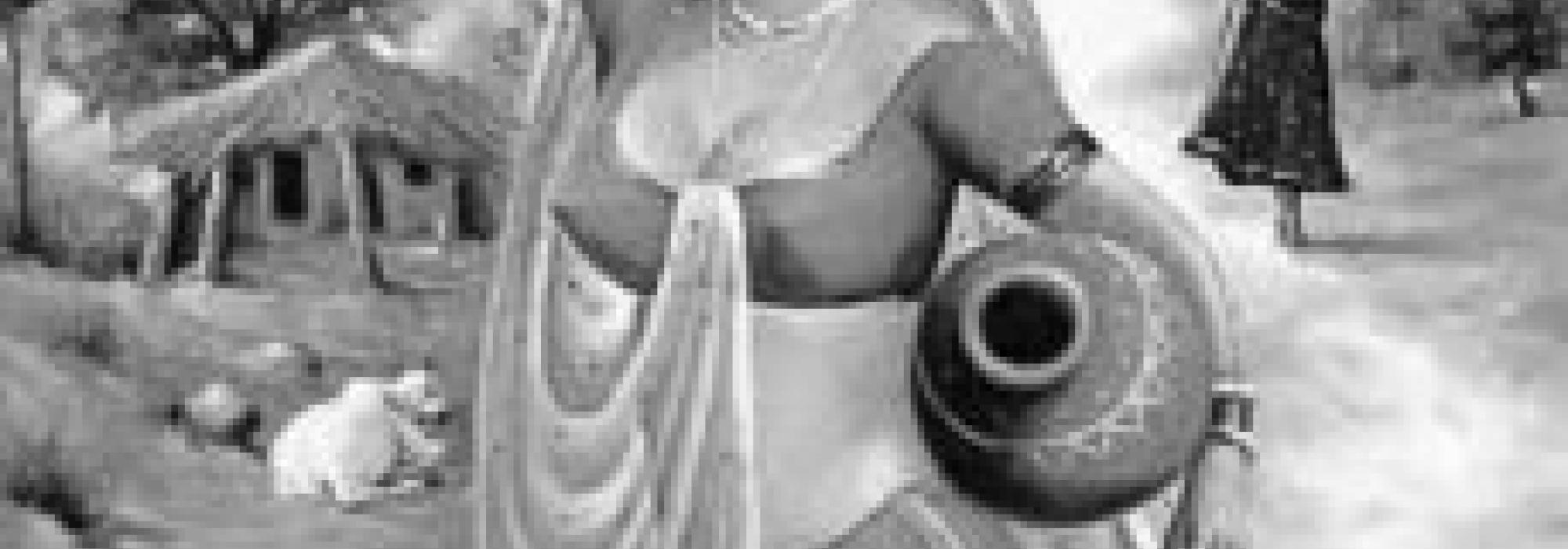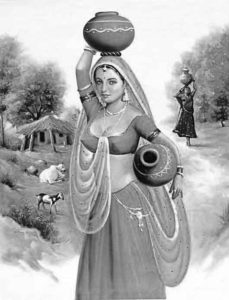Here we see a fluttering of the left eye of a woman separated from her husband. For women, this is a good omen indeed! Anticipating the return of her husband, she ties a festoon with her eyes to the entrance door and tells the left eye, “O Left Eye, who signalled the good omen of my husband’s return! Out of gratitude for your help to me, I will first see my husband through you and will reward you in that manner.” Look here, we find a charitable rest-house; a place where weary travellers are offered water to quench their thirst. There’s a beautiful girl here who offers the water. A handsome young man has arrived at the rest-house for a drink of water; having knelt down, he has cupped his palms and extended his forearms to receive the water. Gawking at his face, the damsel slows down the speed of pouring the water while the handsome young man, staring at her face, spreads out the fingers of his cupped palms. They harbour such desire to continue looking at each other’s faces! What a scheme they’ve figured out! Similarly, another beautiful maiden comes with a plate to give alms to a handsome young man. Crows have emptied all the rice on her plate as well as in his begging bowl and yet the two of them have not realized it! Here we find a young adolescent couple. With the excuse of climbing down the steep bank of the Godavari, she is walking ahead by clinging close to his chest, holding his hands. In a bid to be the perfect giver of refuge to her, he holds her body even tighter. Look here, there’s a lovelorn girl, who is wearing in her hair a faded, fragrance-less Oleander flower simply because it was given to her by her husband; she is walking like the village goddess sporting this faded flower! Here we see a firm-hearted woman chastising a young man who is Manmatha incarnate: “You claim that nobody but your wife is chaste! But don’t you see that you are the reason for it!” Ah! See this couple who are madly in love; when the entire village is on fire and when everyone is running helter-skelter, they hold hands and pour water on the fire together—unmindful of their wealth and property—and in this manner find delight in the activity, just like they are sporting in water. Here is a woman who is having a secret affair; the moment she lays eyes on her paramour she closes her eyes, desiring for secret to be intact. But who can ever cover up one’s horripilation? These secret lovers have surreptitiously come together. In a bid not to be seen by anyone, they have turned out the lamps; with a hundred promises and oaths, they are holding their breaths; they are hugging each other in such a manner that their lips don’t get wounded! And look here, how charming are the nail-marks of the husband on the rose red-coloured breasts of this beautiful lass, looking like the crescent moon in the evening sky. Another innocent girl deems these nail-wounds to be vermillion marks and is trying to clean them repeatedly, but in vain. There, a smart young woman, during the amorous hours, sends away her pet parrot whom she herself has nurtured. If not, the next morning, the damned parrot would expose all the events of the night to the townsfolk. This bride and groom, worried about their separation during the month of Āṣāḍa, are already sweating during the Pāṇigrahaṇa ritual in their wedding! Oh! See the connoisseurship of the lamp! Seeing the sweet and passionate sport of the newly-weds on the night of their wedding, although bereft of oil, this lamp continues to burn bright! Is there any better example to indicate the enjoyment and taste of this world, this era, and these people?
These are from the immortal, śṛṅgāra-laden poetic anthology of King Hāla Śātavāhana, Gāhāsattasaī composed in Mahārāṣṭrīyaprākṛta.
Epilogue
The Gāhā-satta-saī (in Prakrit) or Gāthā-sapta-śati (in Sanskrit)—literally ‘seven hundred songs’—is an extraordinary anthology of muktakas (standalone verses) composed in Mahārāṣṭrīyaprākṛta. It is among the early works of the classical period. It spans from the Imperial Maurya period all the way up to the Gupta period – from Changragupta Maurya to Chandragupta Vikramaditya. It is the oldest available literature after Vālmīki, Vyāsa, Aśvaghoṣa, and Bhāsa. It was compiled by the famous king Hāla Śātavāhana (also called Śālivāhana, Āḍhyarāja, etc.), perhaps in the first century CE. We don’t have many details about this king. He might have been the one who started the Śālivāhana Śaka (Era). We can, however, be certain that he was a great benefactor of savants and himself had the heart of a poet. He ruled the region of modern-day Maharashtra from his capital Pratiṣṭhāna (modern-day Paithan, near Nasik). From the poems in this work, we clearly see that the entire culture of the Śātavāhanas was deeply rooted in Sanātana-dharma.
The term ‘śātavāhana’ refers to the emblem of ‘śāta’ – the lion depicted as the mount, used by the kings of his dynasty. We find references to him in Somadeva’s Kathāsaritasāgara. Guṇāḍhya’s Bṛhatkathā—now unavailable—is supposed to have contained information about him.
The Gāhā-satta-saī is an anthology of Prakrit poems. The similarity in the Sanskrit and Prakrit names of this work extends in general to Sanskrit and Prakrit as a whole. It must be said here that Sanskrit and Prakrit are the two faces of the same coin. While the former is the formal language, the latter is the colloquial equivalent that includes the spoken word. Even today we find that the same language is spoken differently in different regions while there is homogeneity in the formal, written language.
The title of the work suggests that there are seven hundred verses but the actual number is much higher, close to two thousand; it is likely that the collection grew over time. The verses are all composed in the Āryā poetic meter. Āryā is a mātrā-jāti chandas; the meter depends on the number of mātrās (shortest recognizable utterance) and gaṇas (group of mātrās). Āryā has the following pattern: 12-18-12-15 (twelve mātras in the first pāda, eighteen in the second, twelve in the third, and fifteen in the fourth.) Each gaṇa has four mātras.
Saptaśati can be considered as a genre in itself. Just as the Rāmāyaṇa became the model for classics, this anthology became the model for standalone verses. Sapta (seven) is symbolic of intimacy and friendship in Sanātana-dharma as seen from the dictum ‘sakhā saptapadā bhava’ and Jyautiṣa’s usage of number 7 for determining compatibility. Śata (hundred) is a symbol for longevity and fullness as seen in numerous sūktas in the Vedas. We find both these sentiments abundantly in this magnum-opus of folk poetry.
The Gāhā-satta-saī is the work of several poets including Hāla, Pravarasena, Anaṅga, Pālita, Mayūra, and Narasiṃha. Many poets are anonymous in the anthology. This being a compilation of select verses of a number of poets—close to three hundred—several of the verses are of a high quality. Also, since they are standalone verses, a connoisseur can read and relish them, starting anywhere, stopping anywhere.
The poems primarily deal with the rasa of śṛṅgāra, which can loosely be translated as ‘romantic love.’ They capture such tender feelings that are so natural and endearing. It is a wonderful example of a literary work that captures the lives of common folk. The description of natural beauty, incisive observations of daily life, and the subtle prescriptions of moral precepts are woven intricately in these poems.
Connoisseurs, scholars, and common folk have all extolled the greatness of this work, right from the beginning. Bāṇabhaṭṭa says in his Harṣacarita (1.13) –
अविनाशिनमग्राम्य- मकरोत्सातवाहनः।
विशुद्धजातिभिः कोशं रत्नैरिव सुभाषितैः॥
He pays a charming tribute to Hāla when he says ‘viśuddhajātibhiḥ kośaṃ ratnairiva subhāṣitaiḥ’ – literally ‘his sayings are treasures of high quality precious stones.’ The word ‘jāti’ means ‘category’ and also refers to the generic name of the mātrā metres (one among which is Āryā, the meter of the poems of the Gāhā-satta-saī). The suggestion of this verse is that Hāla Śātavāhana filled his coffers with indestructible jewels of refined subhāṣitas (literally ‘good words’). There is also a play on the word ‘kośa’ since an alternative name for his work is ‘Gāhā-kosa’ (or ‘Gāthā-kośa’). In fact, Gāhā-kosa seems to have been the earlier name; when the number of verses in the work reached seven hundred, the ‘saptaśati’ must have been added to it. In Sanskrit literature there are many other such seven-hundred-verse poems including Durgā-sapta-śati and Āryā-sapta-śati.
The renowned Telugu poet Śrīnātha (c. 15th century CE) was enamoured by these poems and translated them into Telugu. Ever since, a host of poets and writers have translated the work into several languages. In the 20th century, the great scholar-poet Rallapalli Anantakrishna Sharma translated this work beautifully into Telugu (in poetic form). Jagannatha Pathaka translated it into Hindi (in prose). S V Parameshwar Bhat translated it into Kannada (in poetic form). There are translations of this work in a host of Indian and foreign languages.
It is noteworthy to mention here that one finds a lot of resemblance of the depiction of the scenarios, the style, and the setting with the poems of the Sangam literature of Tamil (dated variously between 1st century BCE and 3rd century CE).[1] The Sangam treatises are also often anthologies and several of the poems come under the category of Agam (themes of love, romance, marriage, family life, and so on). This likeness is, however, not surprising because the first century CE was the start of the classical age in India. We know from history that there has always been a pervading oneness in the culture of India across its length and breadth.
हालमेव सदावन्दे येन प्राकृतभाषया।
नीतापि भारती नैव मन्यते च्युतसंस्कृतम्॥
– शतावधानि रा. गणेशः
I forever salute Hāla! Although he brought Prākṛta to the forefront, Sarasvatī doesn’t feel that Saṃskṛta (referring to both ‘Sanskrit’ and ‘refinement’) was relegated to the background.
(From Dr. R Ganesh’s Śatāvadhānaśrīvidyā)
This is the third and concluding part of an English translation of a remarkable Kannada essay by Śatāvadhāni Dr. R Ganesh titled ‘Gāhāsattasaī’ya Amaraśṛṅgāra from his anthology Hāsu-bīsu. The translators would like to express their heartfelt thanks to Dr. Ganesh for his detailed review of the translation. Thanks to G S Raghavendra for his kind review and valuable suggestions.
The Epilogue has been drawn from Dr. Ganesh’s lecture series (December 2007, Gokhale Institute of Public Affairs) on the Gāhāsattasaī as well as the introductory address by Dr. S R Ramaswamy.
Footnote
[1] Translators’ Note: Those interested to know more about the similarities between the Sangam Tamil literature and the Gāhā-satta-saī can refer to Dr. Ganesh’s essay titled ‘Tamiḻu-Prākṛtagaḻalli Praṇaya’ (pp. 92-101) from his anthology ಭಾಷಾಭೃಂಗದ ಬೆನ್ನೇರಿ (Bangalore: Vasanta Prakashana, 2017).


















































